Notizie per Categorie
Articoli Recenti
- New whitepaper outlines the taxonomy of failure modes in AI agents 24 Aprile 2025
- Understanding the threat landscape for Kubernetes and containerized assets 23 Aprile 2025
- [Launched] Generally Available: Instance Mix for Virtual Machine Scale Sets 22 Aprile 2025
- Microsoft’s AI vision shines at MWC 2025 in Barcelona 22 Aprile 2025
- [Launched] Generally Available: Announcing the Next generation Azure Data Box Devices 22 Aprile 2025
- [Launched] Generally Available: Cross-Region Data Transfer Capability in Azure Data Box Devices 21 Aprile 2025
- [Launched] Generally Available: Azure Ultra Disk Storage is now available in Spain Central 21 Aprile 2025
- [Launched] Generally Available: Azure Firewall resource specific log tables get Azure Monitor Basic plan support 21 Aprile 2025
- Hannover Messe 2025: Microsoft puts industrial AI to work 21 Aprile 2025
- Securing our future: April 2025 progress report on Microsoft’s Secure Future Initiative 21 Aprile 2025
Optimize sustainability data management across your value chain
Sustainability is a global issue that requires collective action and a collaborative approach. This includes organizations gathering and analyzing complex environmental, social, and governance (ESG) data from across wide-ranging value chains. This data is variously formatted and diffused, and collecting and managing it isn’t easy. That’s why Microsoft is committed to delivering Microsoft Cloud for Sustainability solutions that enable better data visibility, management, and sharing across whole operations and value chains, supporting both organizational and collective progress.
Try Microsoft Sustainability Manager Premium
A solution that unifies data to help you monitor and manage your performance

In this blog, we show you how the ESG value chain solution in Microsoft Sustainability Manager enables you to gather data directly from your value chain partners, streamlining supplier engagement to gain a more comprehensive and accurate picture of those suppliers’ environmental impacts that contribute to your own company’s impacts. With better access, management, and integration of shared sustainability data, you can get ahead of Scope 3 data challenges and move faster toward your targets. We also share what we’re doing to drive improved data sharing globally, and we highlight recent updates to Microsoft Cloud for Sustainability.
Spotlight on Scope 3 data collection and sharing
Gathering and processing value chain data can be especially resource-intensive and time-consuming for large and global organizations with thousands of value chain partners that do business with them, are otherwise invested in their organization, or whose data they need to collect. The ESG value chain solution simplifies this process by providing a centralized and secure platform to collect, validate, and aggregate data from these partners.
Enable precision Scope 3 emissions data collection
Improving the quality and reliability of your Scope 3 emissions data from indirect upstream and downstream activities requires precise, granular data from your value chain partners. With ESG value chain surveys, you can request either the qualitative and quantitative data you need or different datasets from different groups of partners. Surveys help you gain a deeper and more nuanced understanding of your Scope 3 emissions and pinpoint the areas where you can make the most impact.
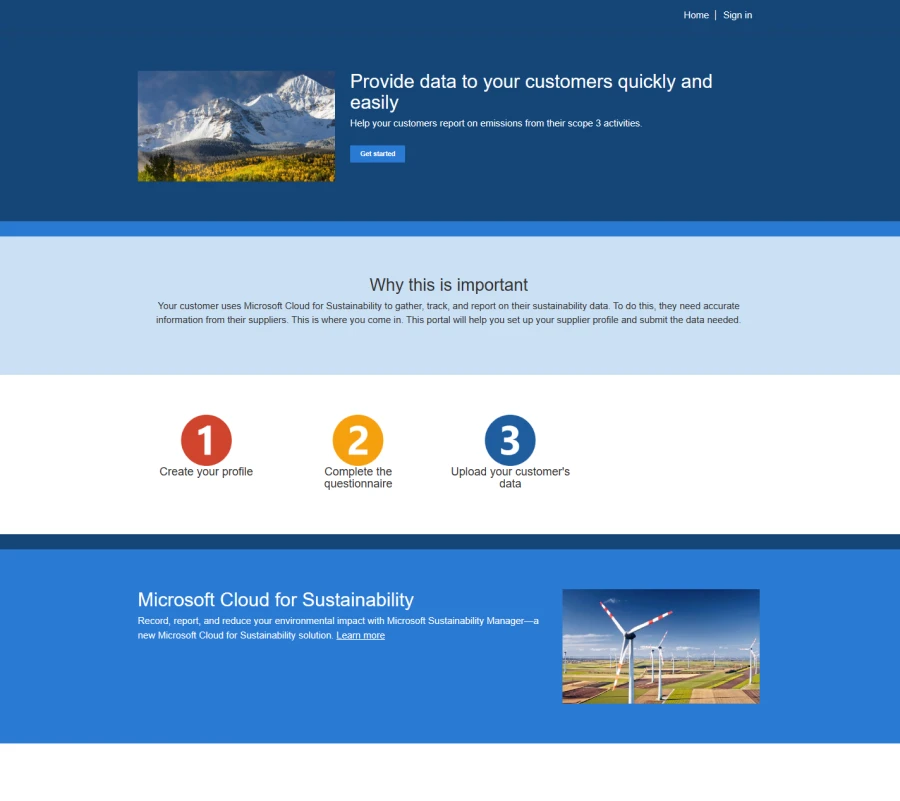
Scope 3 emissions accounting also requires ongoing engagement and communication with your value chain partners. With ESG value chain solution tools, we have simplified the supplier data collection process. Organizations can invite, onboard, and collect data from partners, helping you increase confidence in Scope 3 accounting processes and data.
Additionally, you can use suppliers’ ESG ratings provided by EcoVadis to see how critical players across your value chain are doing on multiple ESG fronts, for extra visibility into your value chain and supplier footprints. To enable EcoVadis ratings in Microsoft Sustainability Manager, you need to have an account with EcoVadis.
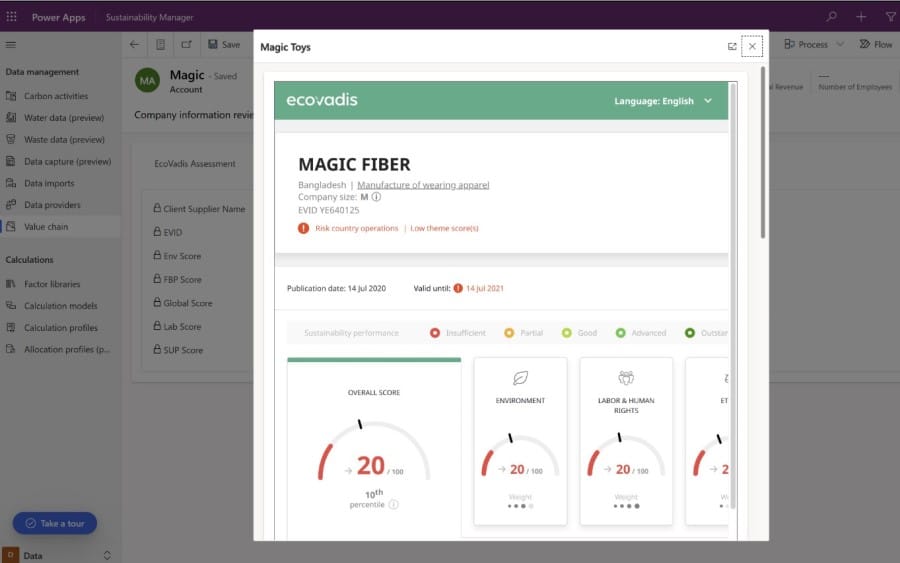
What’s next for the ESG value chain solution?
At Microsoft, we began using the ESG value chain solution to collect data from our own value chain partners in early 2023. Now we’re combining what we’ve learned with feedback from customers to plan for future improvements to the solution, with our next expansion planned for Fall 2024.
How we’re driving broader improvements in sustainability data sharing
Among the biggest challenges in sharing sustainability data is the fragmented and often duplicative manual effort required to share data across value chain partners. To help streamline this process going forward, we’re enabling suppliers and their customers to automatically share and interpret the required data for their own calculations and reporting. This data ranges from the inputs required for carbon accounting, such as energy data, to more granular supply chain data that’s emerging from initiatives like WBCSD: PACT Product Carbon Footprint (PCF) and the European Union Digital Product Passport (DPP).
Microsoft is actively supporting and participating in this effort through initiatives like Carbon Call to better understand and share greenhouse gas (GHG) emissions data, and the WBCSD: PACT initiative, to help develop the global standard for calculating and exchanging Scope 3 emissions data across value chains. We believe these initiatives will help create a more transparent and consistent sustainability data ecosystem.
We’re also working to create sample reference accelerators based on these initiatives, to help our customers and partners leverage Microsoft Cloud for Sustainability and expand the data-sharing ecosystem. To learn more, sign up for the WBCSD Pathfinder Accelerator private preview.
MASSIV+: Working toward net-zero supply chains through cross-industry data sharing
Microsoft is also an active participant in the MASSIV+ consortium of industry leaders in Sweden, working to create a common platform for sharing and validating sustainability data across the consortium’s collective value chain. MASSIV+ aims to enable more accurate and transparent reporting of GHG emissions, starting with Scopes 1 and 2, to more accurately calculate Scope 3 emissions. The partnership aims to achieve net-zero supply chains by 2030 to 2050.
MASSIV+ is defining a new framework around what data to share through its new Sustainability Data Exchange Protocol, layering an organization’s data from high-level company and location data to more granular product-level data through protocol messages. Eventually, MASSIV+ will look to expand capabilities supporting how the data is shared through data spaces that define data sharing policies and contracts.
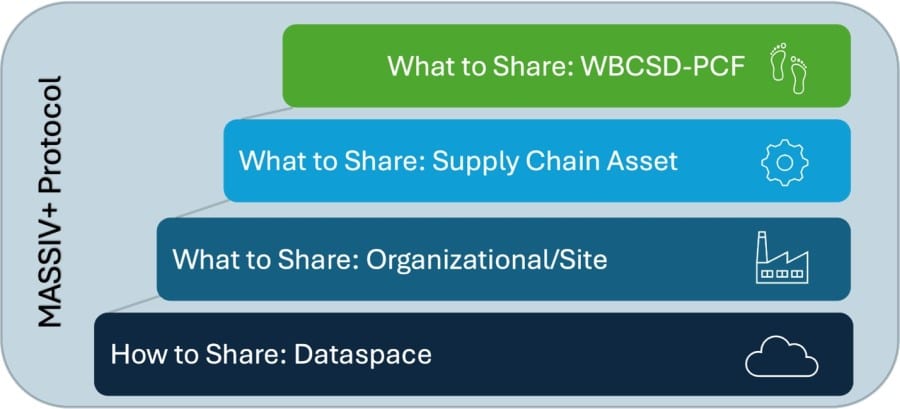
What’s new in Microsoft Cloud for Sustainability
Microsoft Cloud for Sustainability continues to add ESG capabilities to help you accelerate your sustainability progress. Read on for details—and check out our updates page to see a comprehensive summary.
Analytical reporting extensibility
Addressing your organization’s unique sustainability analytics requires a customized approach. With the analytical reporting extensibility in Microsoft Sustainability Manager, now in preview, you can create custom analytical dashboards using the built-in insight pages across emissions, water, and waste as your baseline. Customizing your Microsoft Power BI dashboards to highlight the content most important to your organization will enable faster analysis and decision-making.
Users can select Copy on any emissions, water, or waste report page. This will create a copy of the built-in analytics report pages and will enable them to:
- Edit and delete existing analytical page components.
- Add new metrics or components.
- Change chart types.
- Personalize the page layout.
Once the analytics pages have been tailored to your organizational requirements, simply save your changes and the new dashboard will be available by default to all users who have reporting privileges. Users can switch between the custom and standard dashboards through the custom dashboard (preview) toggle.
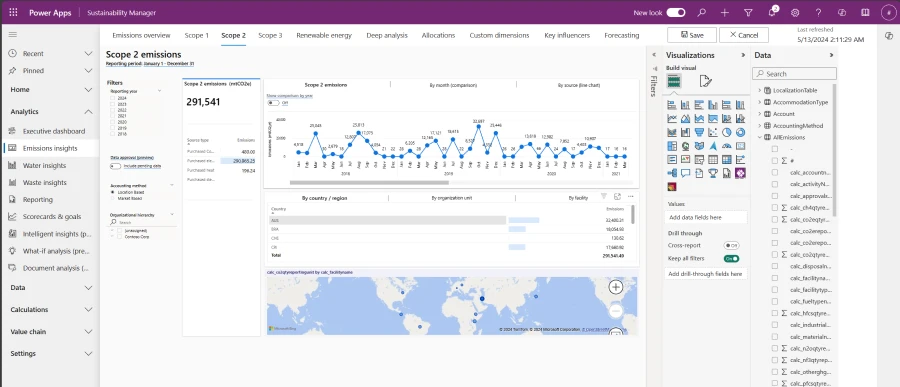
CSRD reporting enhancements
Organizations can generate quantitative reports that extract emissions, water, and waste data from Microsoft Sustainability Manager to satisfy the requirements of the European Union Corporate Sustainability Reporting Directive (CSRD). Understanding the key requirements and data to include in your CSRD preparation report is paramount to a successful disclosure. Once you understand the requirements, you can easily map metrics or data points to the requirements.
This mapping provides you with enhanced efficiency and accuracy when disclosing through CSRD. Organizations no longer need to sift through all their sustainability data to determine what to include to meet the requirements. The quantitative data captured through Microsoft Sustainability Manager can be included in this updated assessment template.
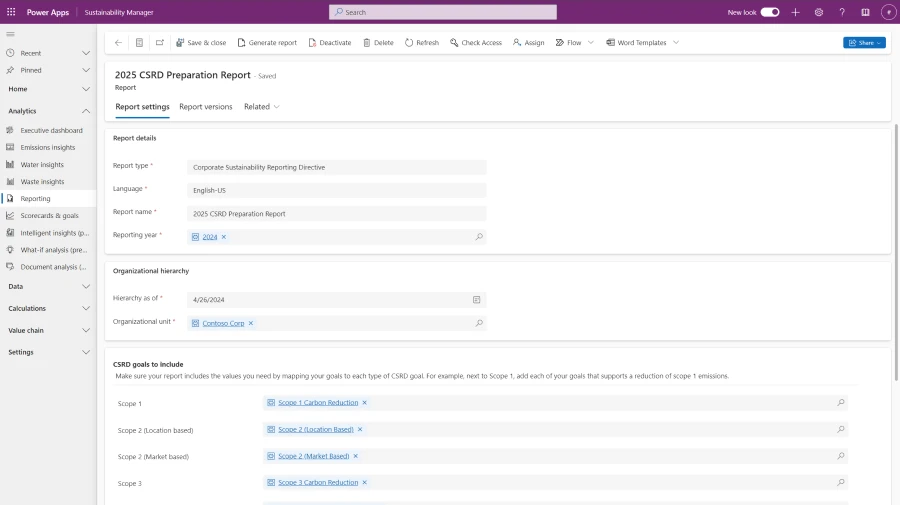
See the requirements and steps to generate a quantitative preparation report.
Audit of disclosure requirements in Microsoft Purview Compliance Manager
Region-specific regulations, such as CSRD, require organizations to perform an assurance audit on the disclosures prior to report submission. Organizations need a mechanism for sharing curated disclosure data along with associated evidence documents required for substantiating the data during the audit process. Assigned auditors need the ability to review the disclosed data and evidence documents against the disclosure requirement and provide their comments.
Auditors can visualize this data against regulatory requirements by using Compliance Manager. With Compliance Manager, you can help ensure your organization’s adherence to CSRD requirements. Auditors can then review the data and the corresponding evidence documents in Compliance Manager against the disclosure requirements and input their approval status along with comments.
Organizations with Sustainability data solutions in Microsoft Fabric (preview) will be able to compute and disclose the required ESG metrics for the sustainability regulations like CSRD. This ESG metrics data can then be visualized in the Compliance Manager against the CSRD assessments leveraging the Purview Sustainability data solutions connector. This way that auditor would have a seamless experience to monitor the status of completion and approvals, plan subsequent actions, and more effectively manage compliance with sustainability regulations.
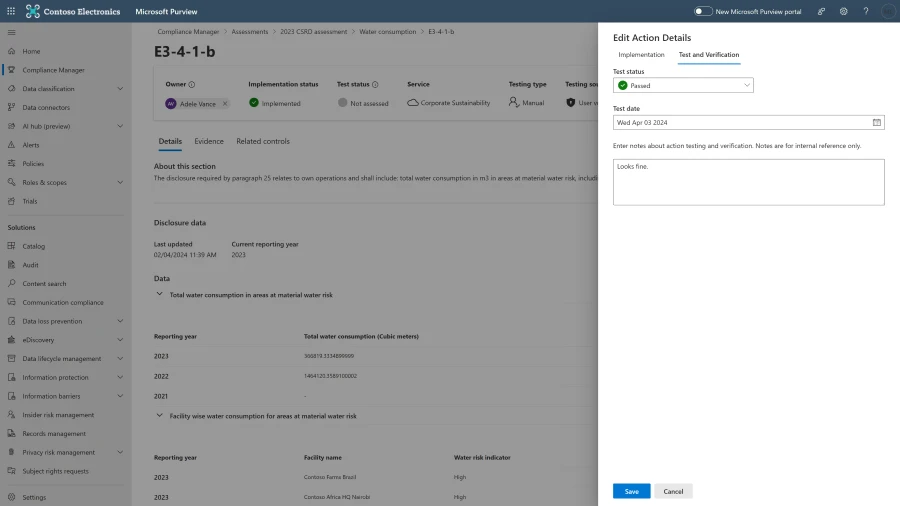
Learn how to enable audit of disclosure requirements in Compliance Manager.
Enhanced country or region mapping capabilities
Some organizations are structured in such a way that regional compliance standards apply to part, but not all, of their operations. These organizations may need to pivot calculations based on specific countries or regions. Microsoft Sustainability Manager now supports the ability to specify custom country or region entries. You can associate an activity or emissions record with a country or region and then design and run relevant calculations.
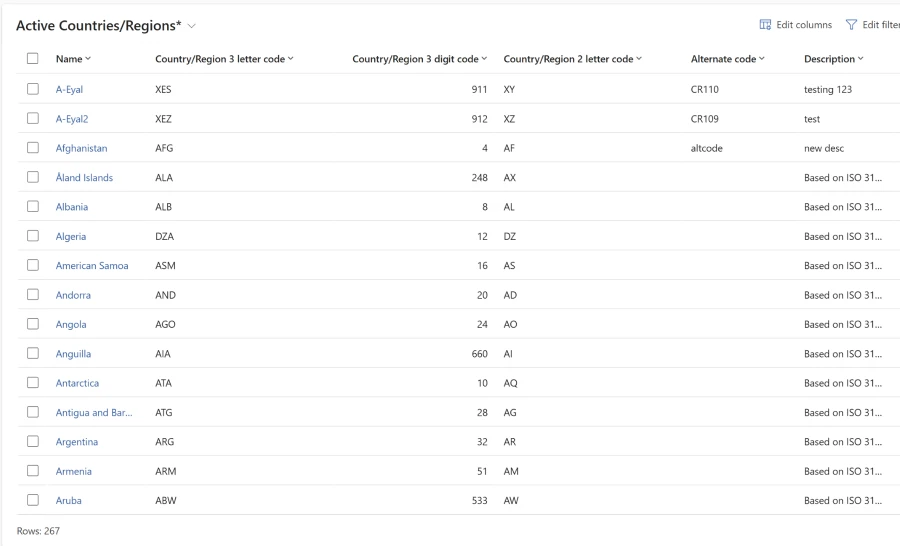
Learn how to create and use custom country or region values in Microsoft Sustainability Manager.
Keep learning about Microsoft sustainability solutions
During the first week of May 2024, the Microsoft Cloud for Sustainability product team hosted our first-ever Technical Summit. The goal was to help our customers and partners understand more complex capabilities and to provide tips and tricks for driving the most impact from Microsoft Cloud for Sustainability features. This included four days of expert-led how-to sessions—all recorded for on-demand reference in our Learn Documentation. Check out the Microsoft Cloud for Sustainability Technical Summit.
More resources:
- Bookmark Microsoft Industry Blogs: Sustainability for the latest updates, including new capabilities in Microsoft Cloud for Sustainability.
- Learn more about Microsoft Sustainability Manager.
- Explore the Microsoft Cloud for Sustainability Community, where you can find answers to questions and connect with peers and experts.
Want to learn more about Microsoft Cloud for Sustainability? Sign up for news and updates.
The post Optimize sustainability data management across your value chain appeared first on Microsoft Industry Blogs.
Source: Microsoft Industry Blog
